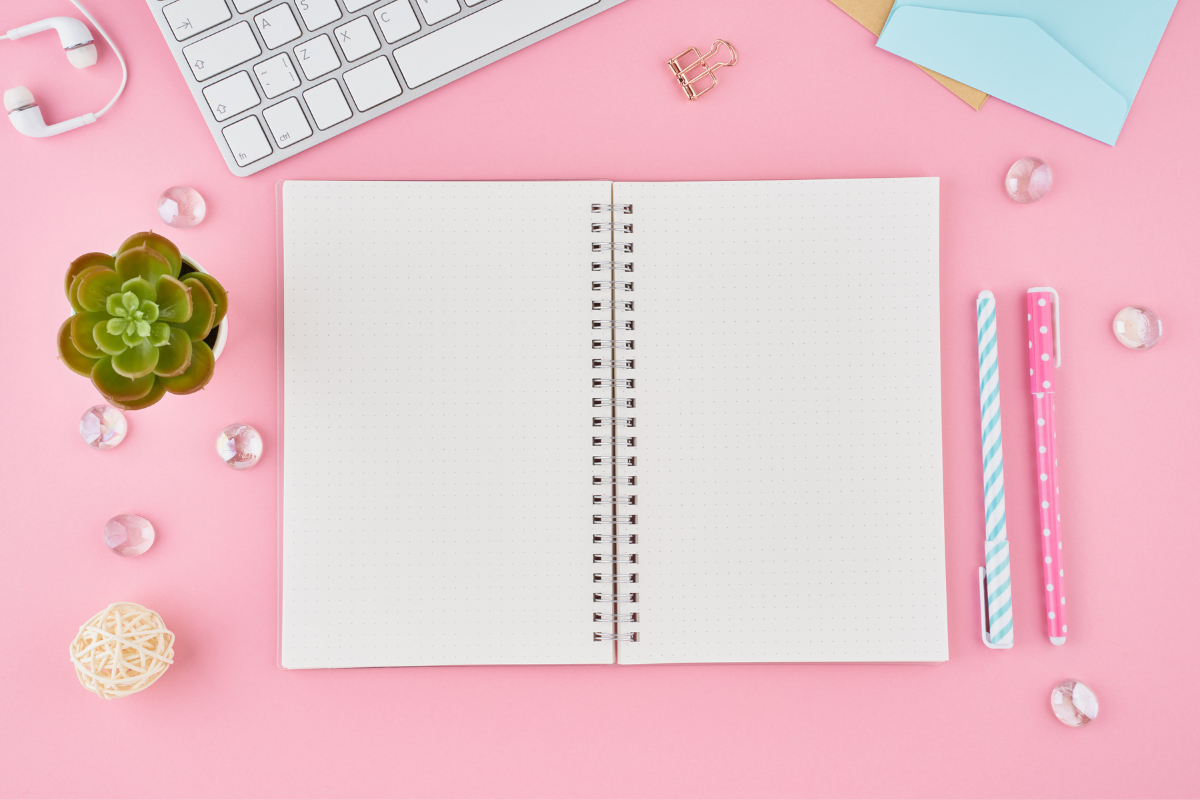Bullet Journal Ideas To Help Get Started

Is your brain on overdrive thinking about your never-ending to-do list? Some people believe that writing down all your thoughts, especially before bed, can help you get organized, manage your thoughts, and get a better night’s sleep.
When it’s written down, you won’t forget, which will naturally help you feel more relaxed.
Writing down things like this in a list of tasks is one way people leverage bullet journaling. Here are some bullet journal ideas to get started and effective ways to use it.
What is a Bullet Journal?
A bullet journal (also called a ‘BuJo’) isn’t a novel-length notebook you stow in a secret place and pour your feelings, hopes, and dreams into. Nonetheless, a bullet journal can very therapeutic. It is still a valuable outlet and is perfect for planning and organizing your thoughts, ideas, and goals and even reviewing your accomplishments.
A bullet journal allows creativity. The pages are blank, dot-grid, or graph lines to record your entries. Plenty of space on the page will enable you to incorporate pictures and designs. You can write your thoughts and ideas in bullet form or short sentences.
The word ‘log’ means a record of events during a voyage. So don’t just keep your BuJo as a tedious task list. Instead, look at life like a voyage, and write things that happen as if you are on a journey, living for yourself.
What Are Some Bullet Journal Ideas?
A bullet journal is something personal and unique that you design to fulfill a purpose, but it can incorporate several ideas. The following is a list of bullet journal ideas to help you understand how to use them and incorporate them into your daily routine.
- DIY planner with calendars, to-do lists, checklists, reminders, and note taking
- Vision boards
- Health and fitness goals like a step tracker, weight training, workout routines, weight loss goals, calorie tracker, sugar consumption tracker, etc.
- Daily or weekly schedules
- Financial goals like an expenditure tracker, budget planner, investment health, retirement saving, children’s education fund, savings goals, bill payment tracker, credit card purchases, etc.
- Songs, movies, and books you love or plan to read or see one day
- Quotes you want to remember that inspire you
- Things you want to accomplish soon (short-term goals)
- Long-term goals
- Meal planning ideas and recipes you want to try
- Things related to a current hobby or creative outlet
- Steps to starting a business or a side hustle
- Areas of the house you want to declutter and items to sell and donate
- Travel planning such as a packing list, hotels to book, flight options, restaurants you want to try
- Words of gratitude
- Cleaning routines
- Gift ideas for all holidays
- Event planning such as birthday parties and dinner parties
- Tracking a habit you want to change or improve, such as exercising more, reading more, getting to bed on time, etc.
- Self-care routine
- Activities with your kids
- Stress and anxiety levels and triggers
- Career goals
- Tracking courses, school work, or continuing education credits, certificates, and professional development
- Volunteer work
- Family bonding ideas
- Your bucket list
- Favorite memories tracker
- Your children’s milestones
- Research for new products you want to purchase
- Shopping list
- Project management
- Art or drawing inspiration/ideas
These are just a few ideas you can use in your bullet journal to help organize your thoughts and time. Even doing a ‘brain dump’ can help get things off your mind.
How Do You Start a Bullet Journal
Bullet Journals have a similar setup that consists of an index, future log, daily log, and monthly log.
1. Index
A bullet journal should have an index because you don’t want to find yourself having to flip through to find particular content constantly. The index lists the names and corresponding pages for each item you wish to record.
2. Future Log
The future log is a list of events that are in the future, basically like a calendar. Examples include birthdays, holidays, vacations, and any other significant events or deadlines that are important to remember. A future log is helpful because when you are working on your daily and monthly records, you can easily reference it to ensure nothing else is going on that day before you make plans.
3. Monthly Log
You can begin this log at any time of the month or year. Jot each month at the top of a new page. Down the sides, write the dates with the first letter of the week beside it. For example, if the first day of August is a Monday, write down M1. Then after that, is T2 down the column, and so on.
There are different ways you can structure the monthly log. For example, some separate the page into columns or sections and write each day of the month on the left and goals and tasks they want to complete on the right-hand side.
4. Daily Log
The daily log doesn’t need to be part of the index. Instead, write your entries as they come to mind, whether it’s a task you need to accomplish or a note about your child winning a soccer game.
You can refer to your daily logs to keep track throughout the day to cross things off your task list and add more entries.
5. Collections
Collections are pages with a specific topic and usually anything that isn’t a log. So, for example, you can record a list of books you want to read, movies to watch, podcasts to listen to, etc.
6. Signifiers or Rapid Logging
This involves using symbols to help give more meaning to your logs. For example, placing hearts beside the entries you want to note are memories and using a color code to streamline topics, assignments, dates, urgency, and more.
Supplies
Don’t procrastinate. You need a plain notebook with blank pages or grid lines and a fine-point pen or felt pen. You can also use a three-ring binder and add more pages. Smaller binders are also available with refillable pages.
Otherwise, let your creativity lead you. You can visit your local craft supply store and stock up on colorful gel pens, stickers, washi tape around the page borders, and highlighters.
Keeping up with a bullet journal has to be manageable. If your first two pages were full of embellishments and pretty fonts and doodles, but you couldn’t keep up with it, your BuJo may become a source of stress or disappointment which defeats the purpose. Ask yourself why you want a bullet journal, and let that guide your purchases to boost your productivity and goals.
How Does a Bullet Journal Help?
A bullet journal crosses between a to-do list, a planner, an organizer, and a diary. An easy-to-use BuJo helps by breaking things like goals down into more manageable, actionable steps and separating them into short-term and long-term goals. Some people believe that if you write things down and visualize what your thoughts are, you are more likely to increase your confidence and do it.
So your entries in your bullet journal should be intentional, meaning they are things you are motivated to do. It’s more than a list of to-do lists. Logging these entries into your BuJo helps make you more accountable.
Bullet journal entries can even have a deeper meaning for some people, like trying to figure out what they want in life. Writing out their goals and where they want to be in life can help people see what they need to do to make change happen.
Try including positive affirmations in your BuJo pages that will continue motivating and rewarding you as you accomplish each goal. The ultimate goal of a bullet journal is to be a relaxation tool to help you love yourself, so use it in a way that best serves you.
Alternatives to Bullet Journal
While formatting a bullet journal is personal, it’s not for everyone. Some people may find other tools like Trello boards or an AirTable easier to organize their thoughts with folders and sticky notes than a paper planner, while others may prefer documents and spreadsheets on Google Drive. In addition, new electronic notebooks and productivity apps like Evernote, Do App, GoodNotes, and more provide iPhone and android users an electronic option to store note pages and thoughts.
Conclusion
The simplicity of the bullet journal helps you get things done while writing down your thoughts, ideas, goals, and tasks. It can feel like releasing a small burden from your brain into a book and help relieve stress through better organization and time management skills.
People who benefit from writing should eliminate sticky notes and incorporate bullet journaling entries into their regular self-care routines.
Remember, don’t overwhelm yourself. There are no actual rules but try not to write in it mechanically like a grocery list. Instead, keep track of tasks, thoughts, and ideas with pictures, symbols, stories, stickers, and much more. A bullet journal is unique to you and should inspire passion, creativity, and a means to set personal goals, no matter how small, and appreciate those accomplishments.
If you are a pen-and-paper person who loves to track your progress and habits, get yourself a BuJo and get started.
This article was produced and syndicated by Wealth of Geeks.






